The MES of the sinking police car suggests the increasing mistrust in the police among black working class communities in New Orleans. The master shot of Beyoncé singing the song while sitting on the police car is constructed through the blue tinted, desaturated colour palette. This colour choice constructs a serious and problematic mode of address, which is further anchored through B’s serious direct mode of address. This is further anchored though B’s confident facial expression, and relaxed body language.
The setting of flooded streets makes explicit reference to the aftermath of Hurricane Katrina. This instantly politicises the music video, and makes intertextual reference to a huge national event that disproportionately affected working class black communities in the state of Louisiana . Clearly, while focussing on elements of poverty, the video has very high production values. However a binary opposition is constructed between Beyoncé's enormous wealth and celebrity, and the dark, depressing, poverty MES of the setting.
Beyoncé is shown standing in a line-up of black clad men, all impassively addressing the camera. A wide angled, mis shot, low angled shot constructs an intimidating mode of address for the target audience. This reference to spiritualist religious iconography suggests a specific and definitive attempt to represent marginalised Afro-American culture. In doing so she is challenging the idea of cultural appropriation, and suggests that ‘black ‘ identity is far more complicated than simply being ‘African American’.
Beyoncé's outfits are varied, contradictory and striking. In one sense this is highly conventional of the pop genre. Yet strangely, Beyoncé wears a variety of different costumes from different eras, constructing a confusing mode of address. This conflicts with the fact that Beyoncé is a highly recognised celebrity, as many of these costumes suggest that Beyoncé is playing a variety of different characters
A highly sexualised address is constructed that conflicts with the political messages of the video. This sexuality is constructed through the montage of her dancing, and is anchored through the MES of her outfit, which emphasises her buttocks, which are emphasised through her hegemonically attractive features and the bright red colour of her hot pants. This cinematography clearly sexually objectifies Beyoncé. However, a polysemic meaning can be formed that constructs Beyoncé as a proud, confident black woman. These sexualised dancing shots also appeal to her core audience and minimise risk and maximise profit.
While Beyoncé dances in a grand, old, antebellum era house, she also dances in a bleak, even threatening parking lot, that connotes a modern setting. The bleakness of the concrete is emphasised through the desaturated colour grading and the ugly VHS filter. The combination of elements construct an ordinary and straightforward lifestyle that engages with and appeal to a working class target audience
The camera slowly pans over the MES of the ugly, scrawled graffiti reading ‘stop shooting us’ which makes reference to the systemic racism in the US police force and numerous incidents of police brutality against black Americans. A stark binary opposition is constructed between the US police force and black Americans.
The music video makes extensive use of cross cutting from a variety of different and contradictory narratives.
A shot/countershot montage is constructed through the montage of the hooded boy dancing in front of the police officers, and constructs a harsh binary opposition between the two of them. The size of the police officers is emphasised through the use of low angles, and the comparative smallness of the boy is reinforced through the use of long shot, which constructs him as vulnerable. The MES of the surrendering police officers and the dancing boy functions as a symbolic metaphor, and suggests that the video is asking the working class black audience to stand up for themselves and to resist authority.




















